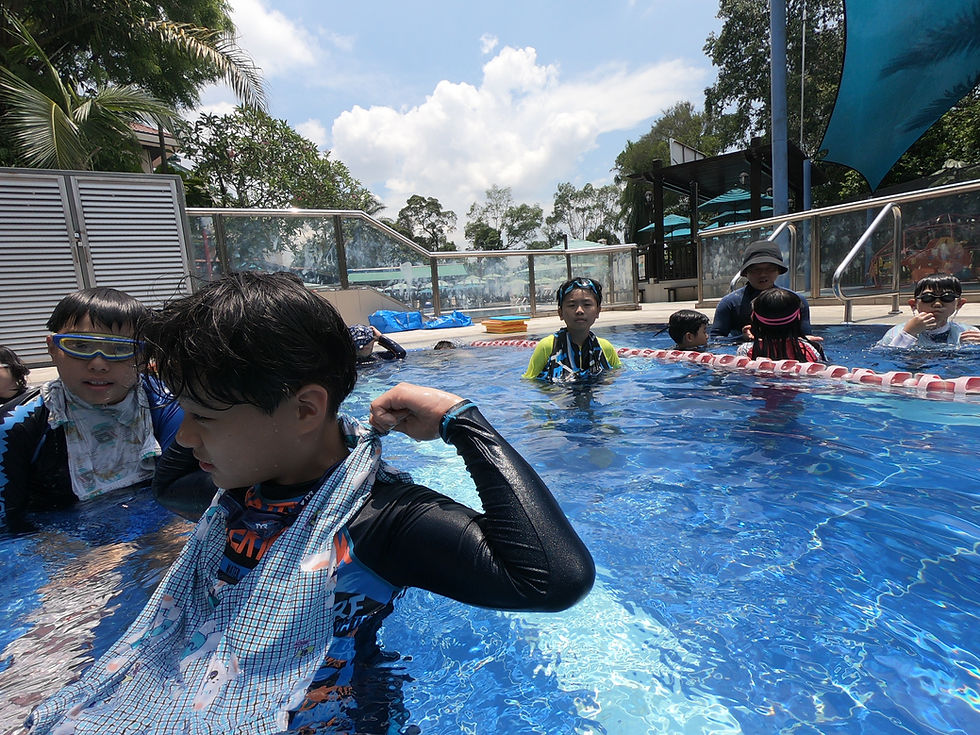How to Train for Triathlon Swims in Murky Waters
- SG Sink Or Swim

- Jun 5, 2025
- 3 min read

One of the unique challenges in triathlon training is preparing for open water swims in murky or low-visibility conditions. Unlike the crystal-clear pool or even some calm lakes, many triathlon venues — especially rivers, ponds, and bays — can have cloudy, dark, or sediment-heavy water. For swimmers accustomed to pool conditions, this can lead to disorientation, anxiety, and performance issues.
But with the right strategies, gear, and mindset, you can not only adapt to murky waters — you can thrive in them. This guide breaks down how to train effectively for triathlon swims in murky conditions, helping you build confidence and control on race day.
🧠 Why Murky Water is Challenging
Swimming in low-visibility water introduces several difficulties:
No visual cues from the bottom or lane lines
Disrupted sense of direction due to lack of landmarks
Psychological discomfort or fear of the unknown
Harder to sight buoys and stay on course
Potential for more contact in crowded race starts
The goal of training in these conditions is to build both technical adaptability and mental resilience.
🏊♂️ How to Train for Murky Water Triathlon Swims
1. Practice Sighting in Every Open Water Session
Since you can’t rely on floor tiles or pool walls, learn to sight effectively:
Lift your head every 6–8 strokes to check landmarks or buoys
Use land-based references (trees, buildings, mountains) when buoys are hard to see
Practice sighting combined with breathing for rhythm
✅ Drill: Swim 200m intervals in open water, sighting every 8 strokes, adjusting as needed.
2. Simulate Low Visibility in the Pool
When open water access is limited, simulate murky conditions:
Wear dark or mirrored goggles in the pool
Close your eyes for portions of each lap, then practice sighting
Train with eyes down to develop better water feel and stroke awareness
✅ Drill: Swim 50m with eyes closed, sighting only at the halfway point.
3. Develop a Reliable Stroke Count
Use stroke counting to measure distance in place of visual cues:
Know how many strokes it takes to cover 25m, 50m, or 100m
Use this to gauge buoy distance or know when to prepare for a turn
✅ Drill: Do descending stroke-count sets and compare distance per stroke.
4. Work on Navigating Without Pool Walls
Murky water often means no turns and no push-offs — train accordingly:
Do long sets in open water or use a swim tether in a small pool
Practice continuous 400m–800m sets without stopping
Use open turns or treads instead of flip turns in the pool
✅ Goal: Build endurance and rhythm without relying on pool structure.
5. Condition Your Mind for Uncertainty
Murky water triggers mental stress for many swimmers — work on mental endurance:
Practice relaxation and visualization before training sessions
Swim with eyes closed for brief sets to get comfortable in the unknown
Train with triathlon starts: mass entries, group swims, close contact
✅ Mindset Tip: Remind yourself, “I don’t need to see — I need to feel and trust my stroke.”
6. Train with Equipment That Mimics Race Conditions
Use open water goggles with wide visibility and anti-fog lenses
Try wetsuits if race conditions allow — they add buoyancy and security
Practice removing goggles mid-swim and reapplying — in case of fog or leaks on race day
✅ Pro Tip: Practice gear transitions in the same conditions you'll race in.
7. Include Race-Specific Brick Workouts
Triathlon swims aren’t standalone events — simulate swim-to-bike transitions:
Do a 20–30 minute open water swim, followed by a short bike ride or jog
Train your body to adjust from disorientation to land-based movement
✅ Drill: Swim 800m in murky water, jog barefoot for 200m, repeat 2–3 rounds.
🧭 Summary: Key Tips Checklist
Challenge | Solution |
Low visibility | Practice sighting, simulate with goggles |
Disorientation | Stroke counting and mental rehearsal |
No walls or lanes | Continuous swims and tether training |
Mental discomfort | Controlled exposure and visualization |
Race day unpredictability | Gear simulation and race-style starts |
🏁 Final Thoughts
Training for murky water swims isn't just about being physically prepared — it's about being adaptable, composed, and confident in unpredictable environments. By incorporating these techniques into your triathlon training, you'll build the physical control and mental sharpness needed to navigate any open water challenge.





Comments